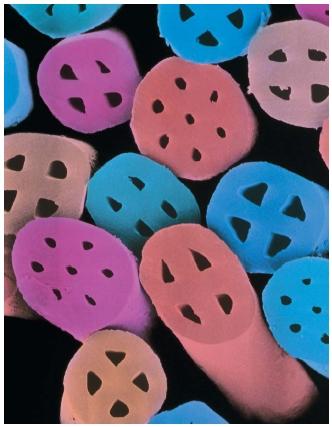Artificial fibers
An artificial fiber is a threadlike material invented by human researchers. Such fibers do not exist naturally. Some examples of artificial fibers include nylon, rayon, Dacron™, and Orlon™. These terms illustrate that some names of artificial fibers are, or have become, common chemical names (nylon and rayon), while others (Dacron™ and Orlon™) are proprietary names. Proprietary names are names that are owned by some company and are properly written to indicate that the name is a registered trademark (™).
Most artificial fibers are polymers. A polymer is a chemical substance that is produced when one or two small molecules are reacted with each other over and over again. The beginning molecule used in making a polymer is called a monomer. When two different monomers are used, the product that results is called a copolymer.
An example of a copolymer is nylon, first invented by American chemist Wallace Carothers (1896–1937) in 1928. The two monomers of which nylon is made are complicated substances called adipic acid and hexamethylenediamine. For simplicity, call the first monomer A and the second monomer B. A molecule of nylon, then, has a structure something like this:
-A-B-A-B-A-B-A-B-A-B-A-B
The dashes at the beginning and end of the molecule indicate that the -A-B- sequences goes on and on until it contains hundreds or thousands of monomer units.
The usual process by which artificial fibers are produced is called spinning. When a polymer is first produced, it is generally a thick, viscous (sticky) liquid. That liquid is forced through a disk containing fine holes known as a spinneret. The spinneret may be suspended in the air or it may be submerged under water. As the polymeric liquid passes through the spinneret holes, it become solid, forming long, thin threads.
The properties of an artificial fiber can be changed in a number of ways, including the way in which the polymer is first produced, additives that may be attached to the polymer, and the way the polymer is processed through the spinneret.

Other synthetic fibers
Artificial fibers can be made by processes other than polymerization. Glass fibers, for example, can be produced by melting certain kinds of glass and then forcing the melted material through a spinneret to form long, thin threads. Many of these artificial fibers not made from polymers are the result of recent chemical research and show exciting promise for new applications in industry.
[ See also Polymer ]
it is very strong and it is good
see how man are intellegent to find like this useful things
for the people
This page is very very useful for me.
I hope that it is also very useful for my dear friends.
please give me answer
Thank you